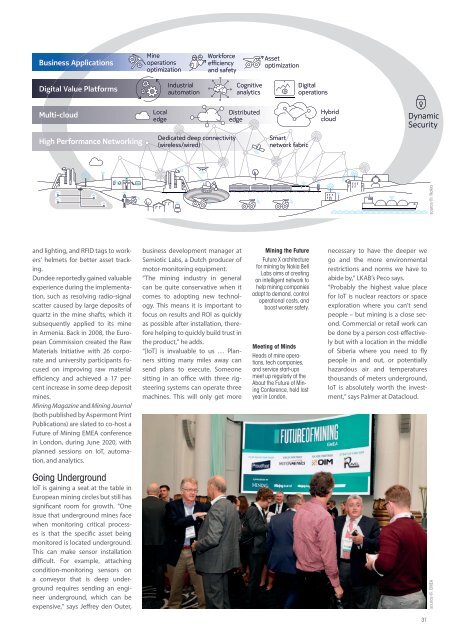Smart Industry 1/2020
Smart Industry 1/2020 - The IoT Business Magazine - powered by Avnet Silica
Smart Industry 1/2020 - The IoT Business Magazine - powered by Avnet Silica
- No tags were found...
Create successful ePaper yourself
Turn your PDF publications into a flip-book with our unique Google optimized e-Paper software.
Business Applications<br />
Mine<br />
operations<br />
optimization<br />
Workforce<br />
efficiency<br />
and safety<br />
Asset<br />
optimization<br />
Digital Value Platforms<br />
Industrial<br />
automation<br />
Cognitive<br />
analytics<br />
Digital<br />
operations<br />
Multi-cloud<br />
Local<br />
edge<br />
Distributed<br />
edge<br />
Hybrid<br />
cloud<br />
Dynamic<br />
Security<br />
High Performance Networking<br />
Dedicated deep connectivity<br />
(wireless/wired)<br />
<strong>Smart</strong><br />
network fabric<br />
and lighting, and RFID tags to workers’<br />
helmets for better asset tracking.<br />
Dundee reportedly gained valuable<br />
experience during the implementation,<br />
such as resolving radio-signal<br />
scatter caused by large deposits of<br />
quartz in the mine shafts, which it<br />
subsequently applied to its mine<br />
in Armenia. Back in 2008, the European<br />
Commission created the Raw<br />
Materials Initiative with 26 corporate<br />
and university participants focused<br />
on improving raw material<br />
efficiency and achieved a 17 percent<br />
increase in some deep deposit<br />
mines.<br />
Mining Magazine and Mining Journal<br />
(both published by Aspermont Print<br />
Publications) are slated to co-host a<br />
Future of Mining EMEA conference<br />
in London, during June <strong>2020</strong>, with<br />
planned sessions on IoT, automation,<br />
and analytics.<br />
Going Underground<br />
IoT is gaining a seat at the table in<br />
European mining circles but still has<br />
significant room for growth. “One<br />
issue that underground mines face<br />
when monitoring critical processes<br />
is that the specific asset being<br />
monitored is located underground.<br />
This can make sensor installation<br />
difficult. For example, attaching<br />
condition-monitoring sensors on<br />
a conveyor that is deep underground<br />
requires sending an engineer<br />
underground, which can be<br />
expensive,” says Jeffrey den Outer,<br />
business development manager at<br />
Semiotic Labs, a Dutch producer of<br />
motor-monitoring equipment.<br />
“The mining industry in general<br />
can be quite conservative when it<br />
comes to adopting new technology.<br />
This means it is important to<br />
focus on results and ROI as quickly<br />
as possible after installation, therefore<br />
helping to quickly build trust in<br />
the product,” he adds.<br />
“[IoT] is invaluable to us … Planners<br />
sitting many miles away can<br />
send plans to execute. Someone<br />
sitting in an office with three rigsteering<br />
systems can operate three<br />
machines. This will only get more<br />
Mining the Future<br />
Future X architecture<br />
for mining by Nokia Bell<br />
Labs aims at creating<br />
an intelligent network to<br />
help mining companies<br />
adapt to demand, control<br />
operational costs, and<br />
boost worker safety.<br />
Meeting of Minds<br />
Heads of mine operations,<br />
tech companies,<br />
and service start-ups<br />
meet up regularly at the<br />
About the Future of Mining<br />
Conference, held last<br />
year in London.<br />
necessary to have the deeper we<br />
go and the more environmental<br />
restrictions and norms we have to<br />
abide by,” LKAB’s Peco says.<br />
“Probably the highest value place<br />
for IoT is nuclear reactors or space<br />
exploration where you can’t send<br />
people – but mining is a close second.<br />
Commercial or retail work can<br />
be done by a person cost-effectively<br />
but with a location in the middle<br />
of Siberia where you need to fly<br />
people in and out, or potentially<br />
hazardous air and temperatures<br />
thousands of meters underground,<br />
IoT is absolutely worth the investment,”<br />
says Palmer at Datacloud.<br />
source ©: EMEA source ©: Nokia<br />
31
















